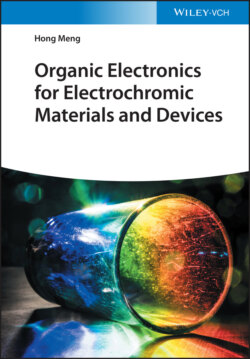Читать книгу Organic Electronics for Electrochromic Materials and Devices - Hong Meng - Страница 12
1.2 The History of Electrochromic Materials
ОглавлениеThe word “electrochromism” was invented by John R. Platt in 1960 [6], in analogy to “thermochromism” and “photochromism.” However, the EC phenomenon could be traced to the nineteenth century, as early as 1815. Berzelius observed the color change of pure tungsten trioxide (WO3) during the reduction when warmed under a flow of dry hydrogen gas. Then from 1913 to 1957, some patents described the earliest form of ECD based on WO3 [7, 8]. Therefore the origins of electrochromism are the nineteenth and twentieth centuries. After then, electrochromism technology began to undergo rapid development, especially the exploration of many classes of EC materials. As showed in the technology roadmap (Figure 1.3), we summarized several generations of EC materials during long‐term development.
Figure 1.3 The roadmap of EC materials development.
The first‐generation EC material is TMOs (e.g. WO3, NiO, and PB). Among them, WO3 plays an important role in the electrochromism field; as the first founded EC material, it has already realized commercialization in smart windows application. PB was discovered as a dye by Diesbach in 1704, and then the electrochemical behavior and EC performance of PB was firstly reported by Neff at 1978 [9]. Benefitted from the structure stability and reversible redox process of those inorganic TMOs, the electrochromism based on the thin‐film TMOs are widely investigated, including the development of new TMOs materials, introduction of new nanostructures, and different element doping.
Following the first‐generation TMO EC materials, organic small molecule EC materials have emerged since 1970. Among them, viologen as the most representative small molecule was first discovered by Michaelis and Hill in 1932 [10], and because of the violet on the reduction, these 1,1′‐disubstituted‐4,4′‐bipyridine compounds were named “viologen.” Then in 1973, Shoot made a new flat alphanumeric display using heptyl viologen; this can be regarded as the beginning of the use of viologen for electrochromism [11]. After a century's development, viologen already has been successfully commercialized. Besides the viologen, other small molecules EC materials such as terephthalate derivatives, isophthalate derivatives, methyl ketone derivatives, and some dye molecules have also attracted much attentions from scientists due to their simple structure and low cost.
The third‐generation EC materials are conjugated polymers. In 1983, Francis Garnier and coworkers firstly characterized the EC properties of a series of five‐membered heterocyclic polymers including poly(pyrrole), poly(thiophene), poly(3‐methylthiophene), poly(3,4‐dimethylthiophene), and poly(2,2′‐dithiophene). Since then, conjugated polymers were given rise to the rapid emerge as a new class of electrochromism [12]. Five years later, Berthold Schreck observed the electrochromism phenomenon of poly(carbazole), which showed a color change from pale yellowish to green together with the conductivity enhancement [13]. To date, the conjugated polymer EC system has been well developed, from better understandings on mechanisms to completed color pallette with soluble or electro‐deposited polymers, and even full‐color display samples or roll‐to‐roll fabricated flexible devices.
Later, in early 2000, triarylamine (TA)‐based aromatic polymers especially the PIs and PAs have drawn considerable attention from the research community as the fourth‐generation EC materials. The correlation between electrochemical properties and chemical structures of different aromatic PIs was firstly described in 1990. Ten years later, Zhiyuan Wang and coworkers [14] reported the first EC behavior of poly(ether naphthalimide)s, which showed stepwise coloration process, from colorless to red and to dark blue corresponding to the neutral, radical anion, and dianion species, respectively. However, due to the high rigidity of the PIs/PAs backbone and strong intermolecular interactions, the poor processability limited the development of PIs or PAs EC materials. Therefore the TA groups were introduced to the PIs/PAs backbone to improve the solubility of aromatic polymers. The first TA‐based polyamide PA was synthesized in 1990 [15], and the first aromatic polyimides integrating interesting EC properties containing TA groups were disclosed in 2005 [16]. Since then, Liou, Hsiao and, other groups have developed numerous TA‐based EC PIs/PAs. Most of the PIs/PAs were solution processible and thermally stable with excellent adhesion with indium tin oxide‐coated glass electrode and had good electrochemical stability. Now the TPA‐based PIs/PAs are considered as great anodic EC materials due to proper oxidation potentials, electrochemical stability, and thin‐film formability.
Benefiting from the bloom and revolution of organic polymers, metallo‐supermolecular polymers were developed by incorporating metal centers into synthetic polymer chains, as the fifth‐generation EC materials. The first metal‐containing polymer, poly(vinyl‐ferrocene), was reported in as early as 1955 [17]. However, due to the insolubility of those macromolecules and the limitation of characteristic technologies in the early years, the metallo‐supermolecular polymers haven't been rapidly developed until the mid‐1990s [18]. Since then, metallo‐supermolecular polymers began to be widely explored in EC field with the advantages of beneficial properties of both organic and inorganic materials. Especially, because the transition metal complexes often exhibit well‐defined redox events and intense charge transfer transitions in the NIR region, metallo‐supermolecular polymers often show potentials in NIR EC application.
More recently, with the active researches on the crystalline and porous MOFs and COFs, the sixth‐generation MOFs/COFs EC materials have emerged. In 2013, the first EC properties of MOFs using naphthalene diimide (NDI) as organic linker were reported by Professor M. Dinca's group [19]. And the first COFs EC material using the TPA as building block was revealed by Yuwu Zhong and Dong Wang and coworkers in 2019 [20]. All in all, some essential features of MOFs/COFs give them advantages in EC, including designable and precise molecular structure, simple self‐assembly synthesis, and porous structure that facilitate the electrolyte ions transport. However, these new EC materials haven't been fully revealed; many efforts should be taken to improve the device performance of MOFs/COFs‐based electrochromism.
